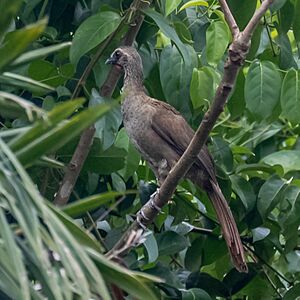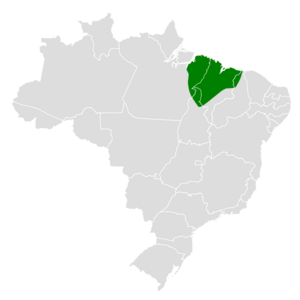Buff-browed chachalaca facts for kids
Quick facts for kids Buff-browed chachalaca |
|
|---|---|
 |
|
| Conservation status | |
| Scientific classification | |
| Genus: |
Ortalis
|
| Species: |
superciliaris
|
 |
|
| Distribution of the buff-browed chachalaca | |
| Synonyms | |
|
Ortalis spixi |
|
The buff-browed chachalaca (Ortalis superciliaris) is a type of bird that belongs to the chachalaca family, called Cracidae. This bird is special because it is found only in Brazil.
Contents
What is the Buff-browed Chachalaca?
The buff-browed chachalaca is a unique bird found in South America. It is part of a group of birds known for their loud calls. These birds are related to guans and curassows.
How is the Buff-browed Chachalaca Classified?
Scientists group living things into categories. This helps us understand how they are related. The buff-browed chachalaca used to be considered a subspecies. This means it was a smaller group within another species. Now, scientists agree it is its own distinct species. It is also "monotypic," meaning it does not have any subspecies itself.
What Does the Buff-browed Chachalaca Look Like?
The buff-browed chachalaca is the smallest bird in its group, the Ortalis genus. It is about 42 to 46 centimeters (16.5 to 18 inches) long.
Colors and Markings
Its head, neck, and upper chest are gray. The rest of its upper body is brown. Its lower chest and belly are a light tan color.
The middle feathers of its tail are dark green-brown. They have chestnut-colored tips. The outer tail feathers are completely chestnut.
Special Features
One special thing about this bird is its eyebrow. It has a clear stripe above its eye. This stripe can be buffy white or a light cinnamon color. This feature makes it stand out from other chachalacas. The skin on its face is a dark slate gray.
Where Does the Buff-browed Chachalaca Live?
The buff-browed chachalaca lives in northeastern Brazil. You can find it south of the Amazon River. It lives in parts of the states of Pará, Maranhão, Ceará, Tocantins, and Piauí.
Habitat
This bird prefers low-lying areas. It lives in scrublands and thick forests. It can even be found in areas where the forest has been changed by humans.
What Does the Buff-browed Chachalaca Do?
Birds have different behaviors for finding food, raising young, and communicating.
What Do They Eat?
Scientists have not studied the buff-browed chachalaca's diet much. However, people have seen them eating fruits from palm trees. They also eat some types of flowers.
How Do They Raise Their Young?
A study in Pará found that these birds nest between December and February. But nests have been seen in other months too.
Nests and Eggs
One nest was described as a flat structure. It was made of twigs, leaves, and grasses. Nests have been found in different places. Some are in tree forks, others on top of tall grass. They can also be found in dense bushes. A female buff-browed chachalaca usually lays two or three eggs.
What Do They Sound Like?
The calls of the buff-browed chachalaca are like other Ortalis birds. However, their calls are higher pitched. They are also less harsh than the calls of the chestnut-headed chachalaca.
Is the Buff-browed Chachalaca in Danger?
The IUCN (International Union for Conservation of Nature) checks on animals. They decide if a species is at risk. The buff-browed chachalaca was once considered "Near Threatened." This meant it might be at risk soon.
Current Status
Since 2012, its status has changed. Now it is listed as "Least Concern." This means it is not currently in danger.
Threats to the Bird
Even though it's "Least Concern," there are still things that threaten it. These include:
- Habitat destruction: Its home is being destroyed or broken into smaller pieces.
- Hunting: People hunt these birds.
- Trade: They are sometimes caught and sold.
All these issues suggest that the number of buff-browed chachalacas might be going down.


